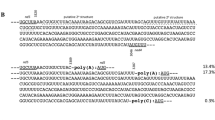Abstract
Initiation of translation in Escherichia coli and related eubacteria involves well-defined interactions between a conserved Shine-Dalgarno (SD) sequence immediately upstream of the initiation codon in the mRNA leader and an equally conserved anti-SD sequence at the 3′ end of the 16S rRNA. SD-like sequences found in the leaders of many, but not all, mRNAs from cyanobacteria and chloroplasts are hypervariable in location, size, and base composition compared to those in E. coli, while anti-SD sequences in the respective 16S rRNAs remain highly conserved. We have examined the function of the SD-like sequences found in the leaders of four chloroplast genes of the green alga Chlamydomonas reinhardtii using replacement mutagenesis to eliminate complementarity with the anti-SD sequences and insertion of canonical SD sequences (GGAGG) at positions −9 to −5 relative to the initiation codon. Promoter-leader regions of the atpB, atpE, rps4, and rps7 genes representing the diversity of chloroplast SD-like sequences were fused to aadA and uidA reporter genes encoding spectinomycin resistance and GUS activity respectively. Analysis of chloroplast transformants of C. reinhardtii and transformants of E. coli carrying the wild-type and mutant reporter constructs revealed that mutagenic replacement of the putative SD sequences had no effect on the expression of either the aadA or uidA reporter genes. Chloroplast transformants with the canonical SD sequence also showed no differences in reporter gene expression, whereas expression of the reporter genes was increased by 10 to 30% in the E. coli transformants. Collectively our results suggest that even though SD-dependent initiation predominates in E. coli, this bacterium also has the capacity to initiate translation by an SD-independent mechanism. In contrast, plant chloroplasts, and very probably their cyanobacterial ancestors, appear to have adopted the SD-independent mechanism for translational initiation of most mRNAs.
Similar content being viewed by others
Author information
Authors and Affiliations
Additional information
Received: 8 July 1997 / Accepted: 9 September 1997
Rights and permissions
About this article
Cite this article
Fargo, D., Zhang, M., Gillham, N. et al. Shine-Dalgarno-like sequences are not required for translation of chloroplast mRNAs in Chlamydomonas reinhardtii chloroplasts or in Escherichia coli . Mol Gen Genet 257, 271–282 (1998). https://doi.org/10.1007/s004380050648
Issue Date:
DOI: https://doi.org/10.1007/s004380050648




